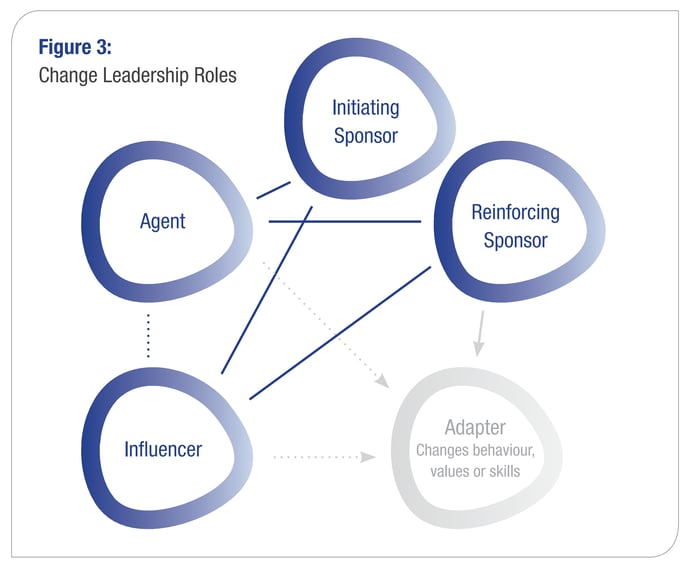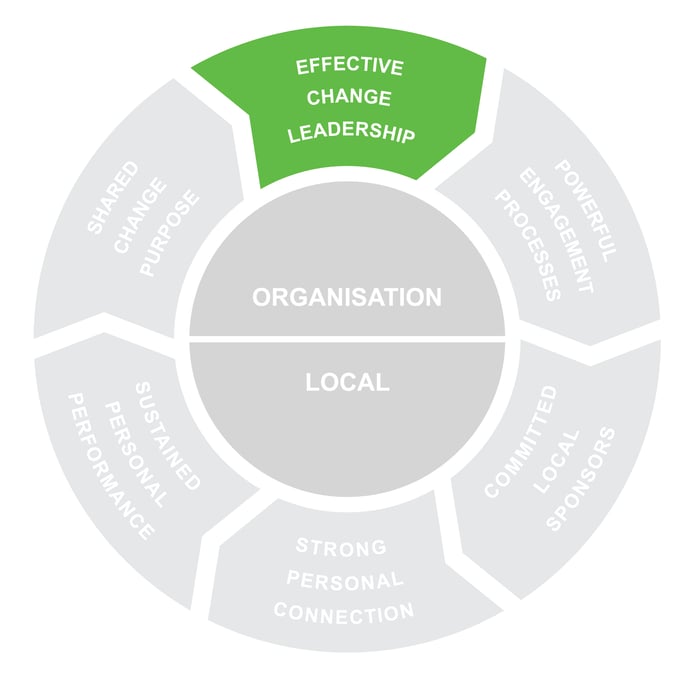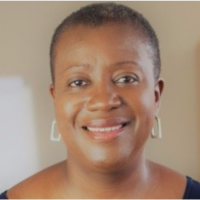
We all wish change was easy, but more times than not it is a tough job. Being an effective change leader when faced with resistance and a challenging change environment might at times seem impossible. And, creating an effective change leadership network might seem beyond impossible. But they are not. It is down to having the right skills in place, and these skills can be learned.
Understanding effective change leadership
Building effective change leadership is the second change management Critical Success Factor (CSF) at the organizational level.
Effective change leadership happens when the leaders of change provide direction, guidance and support to the people who are implementing change, as well as those affected by and working with the change on a daily basis. Done well, this allows people to see their leaders demonstrating their own commitment to the change through their actions as well as their words.
There are three main change leadership roles, each of which has a different skill set and each of which needs to work together with the others. The strength comes from the different scope of power and influence across the organization. Combined, they provide full coverage across the depth and breadth of the organization:
- Sponsor role: brings formal organisational power to authorise, initiate and
reinforce change. - Agent role: adds power to the project with a clear responsibility for planning
and execution. - Influencer role: often lacks formal authority, but has significant informal power
and influence within the change environment.

Planning ahead gives you a firm footing to create the right change leadership structure
Creating this strong, cohesive leadership structure needs time, effort and preparation. You will often find the leaders themselves will be a source of resistance to the change (and each leader will need to go through their own individual reaction and cycle of change).
But without the right change leadership structure in place at the beginning and nurtured throughout the change lifecycle, you risk creating additional resistance within the organization rather than having the structures in place to support and enable people across the organization to cope with and, ideally, embrace the change.
Identifying tools to help overcome hurdles to creating effective change leadership
At the beginning of the change project you need to ensure that everyone understands the different roles they need to play and how you can help them be effective in those roles. A Changefirst technique known as Change Network Mapping can help you identify these roles and who the key players are. In addition, it will help you understand the communications, relationships and power dynamics between them all.
Together with early identification of roles, comes the early identification of skills gaps in your leadership network. Remember, effective change management and change leadership traits can be taught. Early identification of training needs, together with a training plan, will set your change leaders up for success. The Sponsor and Change Agent assessments (described here) provide a gap analysis and help in the identification of training needs.
Don’t underestimate informal power and the influence this has either for or against your change initiative. Map out and understanding the different types of influencers across your organization. This is help you determine who you need to bring into your change leadership network to help drive your change through.
Sponsors often need help to be effective as possible during change. How often have we all seen an executive announce a new change initiative with a lot of fanfare and energy, only to be off focused on the next big thing before this change is complete. Set the expectation of the role of a sponsor early, and coach them throughout the whole change lifecycle to continue to engage, and continue to be active in their sponsorship role.
Some of the other struggles we see in change leadership include declaring victory too early, loosing focus and priority, and the lack of strong leadership rolemodels throughout the life of the change. Don’t forget that your middle and front line managers play an essential role in providing strong change leadership, and are the ones who drive through and provide your local level critical success factors.
The three organizational level, and three local level CSFs, all work together to support effective change management. All six CSFs are integrated into the Changefirst change management methodology, ensuring that they are addressed in a way that supports successful change.
Don’t underestimate the power of an effective change leadership network
It is common for organizations to lack the awareness of the importance of a strong change leadership network during times of change. In fact, poor change leadership is one of the top risks of failure during change management.
Take the time to plan the change leadership network you need in place to succeed, and plan in the time needed upfront and throughout the change lifecycle to train and nurture this essential aspect of your change management structure.



Leave a comment